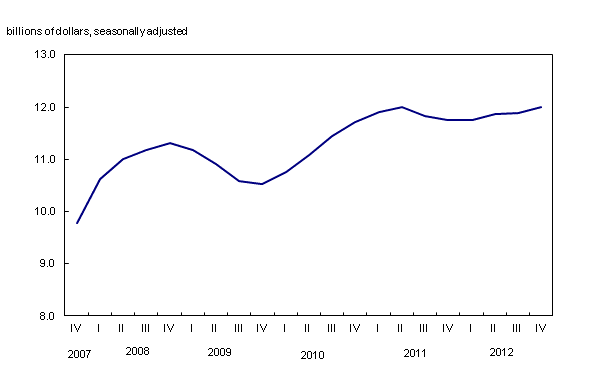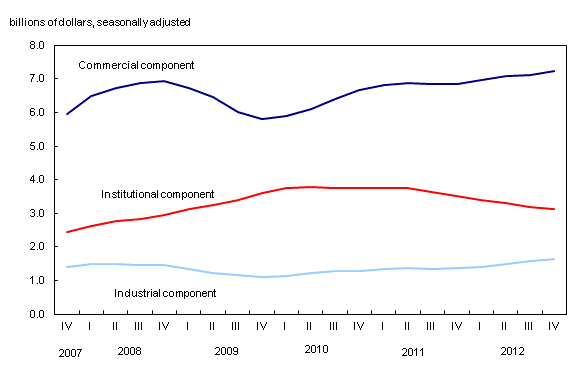Investment in non-residential building construction, fourth quarter 2012
Archived Content
Information identified as archived is provided for reference, research or recordkeeping purposes. It is not subject to the Government of Canada Web Standards and has not been altered or updated since it was archived. Please "contact us" to request a format other than those available.
Related subjects
-
[an error occurred while processing this directive]
Investment in non-residential building construction amounted to $12.0 billion in the fourth quarter, up 1.0% from the previous quarter. This was the third consecutive quarterly increase and was led by higher spending for commercial and industrial buildings.
Investment in non-residential building construction

Chart description: Investment in non-residential building construction
Investment in non-residential building construction was up in six provinces, with the largest increases occurring in Quebec and British Columbia.
The gain in Quebec was spread among the institutional, industrial and commercial components, while in British Columbia the increase was in the commercial and industrial components.
The largest declines in total investment were in Ontario and Alberta. In Ontario, institutional investment was down, while in Alberta the decrease occurred in both the commercial and industrial components.
Census metropolitan areas
Investment increased in 18 of 34 census metropolitan areas. The largest increases were in Vancouver, Montréal, Ottawa and Edmonton.
In Vancouver, investment rose in commercial, institutional and industrial buildings. In Montréal, spending was up for the sixth consecutive quarter, led by gains in the institutional and industrial components. Investment grew in all three components in Ottawa and Edmonton.
The largest declines occurred in Kitchener–Cambridge–Waterloo, Calgary and Toronto. In Kitchener–Cambridge–Waterloo, investment declined for the sixth consecutive quarter as spending fell across all three components.
In Calgary, total investment fell following five consecutive quarters of growth. This drop was the result of declines in both the institutional and commercial components. In Toronto, the decrease was attributable to lower institutional spending.
Commercial component
Commercial building investment increased 1.7% to $7.2 billion, the fifth consecutive quarterly gain. Investment rose in seven provinces, and was led by higher spending on construction of retail and wholesale outlets.
The largest gains in commercial investment were in British Columbia and Ontario. In British Columbia, it rose 7.8% to $855 million, mostly attributable to higher spending for office buildings and retail and wholesale outlets.
In Ontario, investment rose 1.1% to $2.6 billion. The biggest contributors were retail and wholesale outlets and storage facilities.
Commercial investment was down for the second consecutive quarter in Alberta, falling 0.4% to $1.6 billion.
Commercial, institutional and industrial components

Chart description: Commercial, institutional and industrial components
Industrial component
Industrial investment was up for the fifth consecutive quarter, rising 3.3% to $1.6 billion. The largest gains occurred in Quebec and Ontario.
Investment in Quebec rose 9.6% to $315 million, with most of the gain attributable to higher spending in the construction of manufacturing plants and maintenance buildings.
In Ontario, investment increased 4.1% to $579 million, led by spending for utility buildings and maintenance facilities.
The largest decline occurred in Newfoundland and Labrador, where investment fell 21.1% to $47 million, as construction of some manufacturing plants neared completion.
Institutional component
Spending in the institutional component totalled $3.1 billion in the fourth quarter, a 1.8% decline from the previous quarter. Nationally, it was the eighth consecutive quarterly decline in this component. Institutional investment fell in five provinces.
The largest decline was in Ontario, where investment fell 5.5% to $1.6 billion, the fifth consecutive quarterly decline. This reflected lower spending on the construction of educational buildings and health care facilities.
The largest increase occurred in Quebec, where investment rose for the third consecutive quarter. Institutional spending increased 6.7% to $571 million. Most of the increase was attributed to higher spending for health care facilities.
Note to readers
Unless otherwise stated, this release presents seasonally adjusted data expressed in current dollars, which facilitates comparisons by removing the effects of seasonal variations. For more information on seasonal adjustment, see Seasonal adjustment and identifying economic trends.
Investments in non-residential building construction exclude engineering construction (such as for highways, sewers, bridges and oil and gas pipelines). This series is based on the Building Permits Survey of municipalities, which collects information on construction intentions.
Work put-in-place patterns are assigned to each type of structure (industrial, commercial and institutional). These work patterns are used to distribute the value of building permits according to project length. Work put-in-place patterns differ according to the value of the construction project; a project worth several million dollars will usually take longer to complete than will a project of a few hundred thousand dollars.
Additional data from the Capital and Repair Expenditures Survey are used to create this investment series. Investments in non-residential building data are benchmarked to Statistics Canada's System of National Accounts of non-residential building investment series.
For the purpose of this release, the census metropolitan area of Ottawa–Gatineau (Ontario/Quebec) is divided into two areas: the Ottawa part and the Gatineau part.
Available without charge in CANSIM: table CANSIM table026-0016.
Definitions, data sources and methods: survey number survey number5014.
For more information, contact us (toll-free 1-800-263-1136; infostats@statcan.gc.ca).
To enquire about the concepts, methods or data quality of this release, contact Don Overton (613-951-1239), Investment, Science and Technology Division.
- Date modified:
